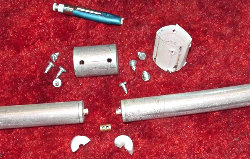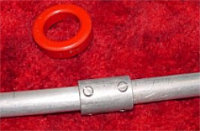Homemade
CATV connectors
By George
Dowell, K0FF
November,
2000
Often 3/4" CATV aluminum feedline is free for the taking. Not
so the connectors, at least any that would be at home in the typical
Hamshack. Here is a way to make weatherproof splices and connectors
s at little cost with readily available parts. All materials used
are made of aluminum, so there is no problem with dissimilar metal
corrosion.
First
we look at the parts needed to make a reliable splice, and
the preparation required:
 In the back-ground
is the shield splice. It is made from a 1/2" he avy wall (threaded)
aluminum conduit coupler. Inside are female threads that are made
to screw onto the male threaded conduit. Try a piece of your cable
for fit. It needs to be just loose enough so that it slides back
and forth over the coax shield. If it s too tight, simply file
the points off the threads with a round file until a perfect fit
results. Drill 8 11/64" holes equally spaced around the periphery,
1/4" back from the edge. You can see the paper template that I
used to assure symmetrical hole patterns.
In the back-ground
is the shield splice. It is made from a 1/2" he avy wall (threaded)
aluminum conduit coupler. Inside are female threads that are made
to screw onto the male threaded conduit. Try a piece of your cable
for fit. It needs to be just loose enough so that it slides back
and forth over the coax shield. If it s too tight, simply file
the points off the threads with a round file until a perfect fit
results. Drill 8 11/64" holes equally spaced around the periphery,
1/4" back from the edge. You can see the paper template that I
used to assure symmetrical hole patterns.
In the foreground is the center conductor splice component. It
is simply a 1/2" long piece of 1/4" copper water supply tubing
that has two 3/32" holes drilled in the side for soldering. Typical
of the material used to connect water to an icemaker.
Dielectric insulation saved from the preparation of the cable
is fashioned into two sabots that will be inserted into the gap
in a later step, minimizing the impedance bump.
A set of eight 3/8" , #8 aluminum self tapping screws completes
the parts list. The points are ground off flat. Start with a 1/16"
drilled pilot hole, start threads with a pointed screw, then remove
and replace with a flat end scew.
Prepare the coax cable by stripping the shield and dielectric
back, leaving a squared end on the center conductor that extends
1/4".
 Assembling
the Splice. Solder the copper tube between the prepared center
conductor ends. Assembling
the Splice. Solder the copper tube between the prepared center
conductor ends.
Step 2: Insert the prepared dielectric plastic into the
gap.
 Step
3: Slide the coupler over the gap and secure with #8 aluminum
screws. Step
3: Slide the coupler over the gap and secure with #8 aluminum
screws.
Step
4:
Apply a little Silicone Grease to the Joints . Note: not
Silicone Adhesive.
 Wrap
entire joint with a few layers of Scotch 33+ and a few light
coats of Krylon Clear over that will assure a weather tight seal. Wrap
entire joint with a few layers of Scotch 33+ and a few light
coats of Krylon Clear over that will assure a weather tight seal.
Comment from
the pro:
Your CATV aluminum splice has at least one major problem and that
is impedance mismatch.
The distance between the center conductor and the shield (aluminum
tubing) which is separated by the dielectric is what determines
the impedance of the cable. Your idea changes this dimension and
as a result changes the impedance.
The "Splice"
also will cause serious mismatch which will reduce the return loss
or VSWR of the cable causing potential problems.
A $10.00 splice is not only worth it, it is much easier to install.
We can supply any splices of connectors for CATV cables
BJ Toner,
Toner Cable Equipment Inc.
21 February 2001
|





